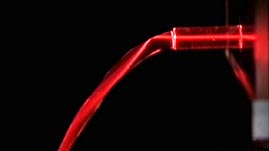Teachers' Domain - Digital Media for the Classroom and Professional Development
User: Preview

Source: The Education Group
In this video from the Encyclopedia of Physics Demonstrations, learn about total internal reflection. A laser beam is aligned so that the light passes through a water tank and out through an opening. As water flows out of the opening, observe how the laser beam remains trapped in the water stream because of total internal reflection. See how the light follows the path of the water even when the flow changes.
While the speed of light traveling through a vacuum is always the same, the speed of light varies as it travels through different materials. When light travels through a material, such as air or water, it is slowed by the particles of the material. The index of refraction (or refractive index) of a material indicates how much the speed of light is slowed relative to the speed of light in a vacuum. The higher the index of refraction, the slower the speed of light.
In a given material, light travels a straight path. However, when light crosses the boundary from one material to another, the change in materials causes the light to experience a change in speed and it is refracted—it bends. The behavior of a ray of light at a boundary can be described by the angles made with respect to the normal line (a line perpendicular to the boundary). When light approaches the interface at an angle, the path of the light changes directions as it crosses the boundary, either bending towards the normal line (as it slows down in the new material) or away from the normal line (as it speeds up in the new material). At most boundaries, some light is transmitted through the boundary and some light is reflected back.
Interestingly, in some circumstances, light traveling from a material with a higher refractive index towards a material with a lower refractive index may not cross the boundary at all. For example, imagine light passing from water to air. As the angle of incidence increases, the refracted light bends farther away from the normal line. At some critical angle (determined by the ratio of the indices of refraction), the refracted light bends 90 degrees from the normal and follows the surface of the water. If the angle of incidence is above the critical angle, none of the light is transmitted across the boundary; rather, all of the incident light is reflected back into the water. This effect is known as total internal reflection.
Diamonds have a high index of refraction, so the critical angle for total internal reflection is easily reached. Diamond gemstones are specially cut to achieve total internal reflection, trapping incident light within the stone. This gives cut diamonds their brilliant sparkle. Fiber optics make use of total internal reflection to transmit information over long distances. Light traveling through the core of an optical fiber (a thin strand of material, usually glass, which is surrounded by a cladding layer), is always completely reflected from the cladding. As a result, no light is lost across the boundary. Furthermore, the signal can undergo many reflections and travel great distances while still remaining strong.
 Loading Standards
Loading Standards Teachers' Domain is proud to be a Pathways portal to the National Science Digital Library.
Teachers' Domain is proud to be a Pathways portal to the National Science Digital Library.
